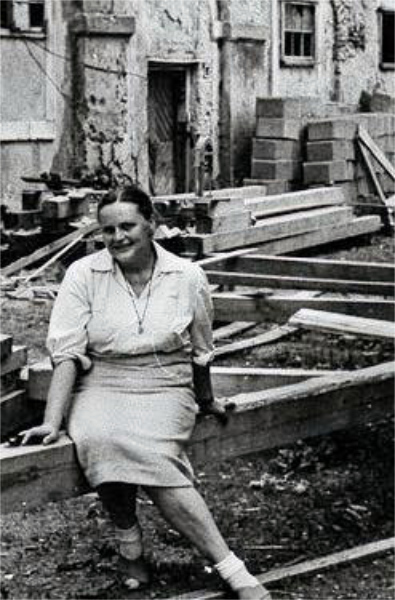Biography
Martha Bolldorf-Reitstätter was born in Innsbruck on 18 February 1912 as Martha Reitstätter. Daughter of a Tyrolean imperial and royal civil servant family, she graduated from high school in Vienna and studied architecture at the Academy of Fine Arts in Vienna under Clemens Holzmeister from 1930. In 1934, she was the first woman to graduate from the academy with a degree in architecture and was already receiving awards for her designs. From the beginning of her studies, she also worked on many prestigious commissions in Clemens Holzmeister’s office such as the Festspielhaus Salzburg (Festival Hall Salzburg). Due to Holzmeister’s travelling activities associated with international projects, Martha Reitstätter was given responsibility for the interior design of the Funkhaus Wien (Vienna’s old headquarter of the National Austrian Broadcast) as a long-time employee and led the planning and construction of the entrance area with main staircase, the large broadcasting hall, other halls and recording studios with high acoustic specifications. Unfortunately, some interior areas were destroyed by bomb damage during the war and were also lost in later adaptations in favour of other designs.
Successful participation in a competition in 1937 led to independent commissions and Reitstätter opened her own architectural office with several employees in 1938. Unlike many of her colleagues, including her mentor and supporter Clemens Holzmeister, the National Socialist seizure of power in 1938 did not damage her career. She was a member of the NSDAP and even the Gauleiter of Vienna, Baldur von Schirach is said to have been so taken with her work that he hired her to adapt private premises.
In 1942-1943 she was on war duty as an architect on the Eastern Front. In the Crimea, in Sinferopol, Melitopol and Sevastopol, she was entrusted with urban planning tasks. In doing so, she acted on behalf of the Organisation Todt, which carried out construction work in German-occupied territories and used concentration camp inmates and prisoners to implement it. (What exactly she did there remains to be further investigated).
Back in Vienna, Reitstätter worked in 1944-1945 on the task force for culture and historic monuments to save and secure war-damaged buildings such as the Belvedere, Schönbrunn, Palais Rasumofsky and St. Stephen’s Cathedral.
Married to the architect Leo Nikolaus Bolldorf von Grazigna since 1946, she was able to continue her career seamlessly after 1945, and in the 30 years that followed she carried out extensive design and construction work, for which she received several awards. She participated in important competitions in Vienna such as Karlsplatz, Stephansplatz, Donauinsel and Museumsquartier. She was involved in urban planning and reconstruction. She realised four housing estates for the municipality of Vienna and was a test engineer for housing reconstruction. Bolldorf Reitstätter also worked as a restorer and furniture designer, organised exhibitions, gave lectures and wrote publications.
From 1970 she was a civil engineer in the Wiener Kammer der Architekten und Ingenieure (Vienna Chamber of Architects and Engineers). Through her husband, a descendant of the Esterhazy family, she also planned and built in Burgenland from the 1950s. There, she was also granted the privilege of being the first female architect to be commissioned by the Catholic Church for buildings for the new diocese of Eisenstadt. An important part of her oeuvre were sacral buildings such as churches, parishes, chapels as well as monuments. In Eisenstadt she realised a high-rise residential building in 1971. This is also worth mentioning since until the 1980s it was not common in Burgenland to award commissions to female architects and master builders. Burgenland then also became her second home when, in 1963, she and her husband bought and restored the Renaissance castle of Kobersdorf, once owned by the Esterhazy family, which was in need of renovation. It became her life’s work until she died on 13 June 2001.
Works (selection)
1938 – 1945
Redesign of the inner city of Vienna with new buildings, additions, and exposures
Development of housing types for a complex at Laaerberg
Designs for youth homes in Litschau and Heidenreichstein
Designs for large housing estates in Floridsdorf
Designs for high-rise buildings
Reconstruction of the Kammerstöckl in Belvedere
1942 – 1943 Deployment for the OT on the Eastern Front in the Crimea
after 1945
1945 In the Wiener Bombeneinsatzstab für Kultur- und historische Baudenkmäler (Viennese bombing task force for cultural and historical monuments); significantly involved in the first restoration work on St. Stephen’s Cathedral
until 1947 Preparation of war damage plans for the municipality of Vienna
1948 Parish of Pitten
1949 War memorial chapel in Hohenberg, Lower Austria
1952 Construction of the new bishop’s residence in Eisenstadt
1949 – 1960 Restoration, planning, and implementation of various sacral buildings in Eisenstadt, including renovation and redesign of the cathedral church
1954 Residential building Grinzingerstraße 49, 1190 Vienna
1959 Housing complex Kleine Mohrengasse 9, 1020 Vienna.
1967 Residential building Franz Schreiner Hof, Buchleitengasse 36-40,1180 Vienna
1981 Residential building Peter Jordan Straße 81, 1190 Vienna
1971 First high-rise building in Eisenstadt
since 1963 Restoration and revitalisation of the castle Kobersdorf/Burgenland, from the property of her husband
Sources
Ute Georgeacopol-Winischhofer: Bolldorf-Reitstätter, Martha, in Keintzel/Korotin (Hg.) Wissenschaftlerinnen in und aus Österreich, Wien, 2002, p. 85F
Iris Meder: Women Designers and Architects in Early Twentieth Century Vienna; in Women’s Creativity since the Modern movement 1918 – 2018, Laibach, 2018, p.56
Ilse Korotin: BiografiA, Lexikon österreichischer Frauen; Bolldorf-Reitstätter, Martha,
Bolldorf-Reitstätter Martha
Arge Architektinnen und Ingenieurkonsulentinnen (Hg.): Frauen in der Technik von 1900 bis 2000; Bolldorf-Reitstätter, Martha, Wien, 2000
Archiv der Republik (Staatsarchiv) AT-OeStA/AdR HBbBuT BMfHuW Titel ZivTech A-G 719, 720
St. Pöltner Zeitung on 27.10.1949, p.7
Amtsblatt zur Wiener Zeitung, 9 January 1948
Dompfarre St. Martin, Baugeschichte, https://dompfarre-eisenstadt.at/
https://www.wienerwohnen.at/hof/1358/Grinzinger-Strasse-49.html
https://www.wienerwohnen.at/hof/376/376.html
https://www.wienerwohnen.at/hof/24/Franz-Schreiner-Hof.html
Photo: Martha Bolldorf-Reitstätter auf der Baustelle in Kobersdorf, 1963, http://www.schloss-kobersdorf.at/(viewed on 18.02.2022)
Text: Christine Oertel
February 2022

